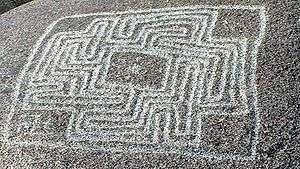Lakeview Mountains
| Lakeview Mountains | |
|---|---|
 Hemet Maze Stone | |
| Highest point | |
| Elevation | 628 m (2,060 ft) |
| Geography | |
 Location of Lakeview Mountains in California [1] | |
| Country | United States |
| State | California |
| District | Riverside County |
| Range coordinates | 33°46′58″N 117°05′09″W / 33.7828°N 117.0859°WCoordinates: 33°46′58″N 117°05′09″W / 33.7828°N 117.0859°W |
| Parent range | Peninsular Ranges |
| Topo map | USGS Lakeview |
| Biome | California chaparral and woodlands |
The Lakeview Mountains are a range of low mountains encompassing approximately 30 square miles (80 km2) of land in western Riverside County, Southern California, at the northern end of the Peninsular Ranges System.
Geography
The Lakeview Mountains are bordered:
- on the south by State Highway 74 and the communities of Homeland and Green Acres
- on the east by the cities of Hemet and San Jacinto
- on the west by the Perris Valley and the community of Nuevo
- on the north by the community of Lakeview and the San Jacinto River. The communities of Juniper Flats and MacLean Ranch are located within the Lakeview Mountains.
The highest point in the Lakeview Mountains is at elevation 2,673 feet (815 m) above mean sea level. Mount Rudolph, a prominent feature at the northerly end of the range, rises to an elevation of 2,595 ft (791 m).
- Petroglyph
Reinhardt Canyon, on the easterly side of the range, is the home of the prehistoric petroglyph known as the Hemet Maze Stone (California Historical Landmark No. 557).[2]
Natural history
The vegetation of the Lakeview Mountains consist primarily of the Coastal Sage Scrub and Montane chaparral and woodlands plant communities.[3]
The Lakeview Mountains are the primary visible trace of the Lakeview Mountains Pluton, consisting primarily of Cretaceous tonalite.[4]
See also
References
- ↑ "Lakeview Mountains". Geographic Names Information System. United States Geological Survey. Retrieved 2009-05-04.
- ↑ Lakeview Quadrangle California, Map. United States Geological Survey, 1953, USGS Topographic Map, 7.5-Minute Series (Topographic), scale 1:24,000.
- ↑ "Western Riverside County Multiple Species Habitat Conservation Plan, Volume I, Section 2.0: Plan Area Description and Setting". Riverside County Transportation and Land Management Agency. 2003-06-17. Retrieved 2007-01-24.
- ↑ Morton, D.M. (1969-01-23). "The Lakeview Mountains Pluton, Southern California Batholith Part I: Petrology and Structure". Geological Society of America. Retrieved 2007-01-24.